Answered step by step
Verified Expert Solution
Question
1 Approved Answer
please sir I only want one paragraph, I hope you don't do copy and paste because the answers from before are not correct. thank you
please sir I only want one paragraph, I hope you don't do copy and paste because the answers from before are not correct. thank you
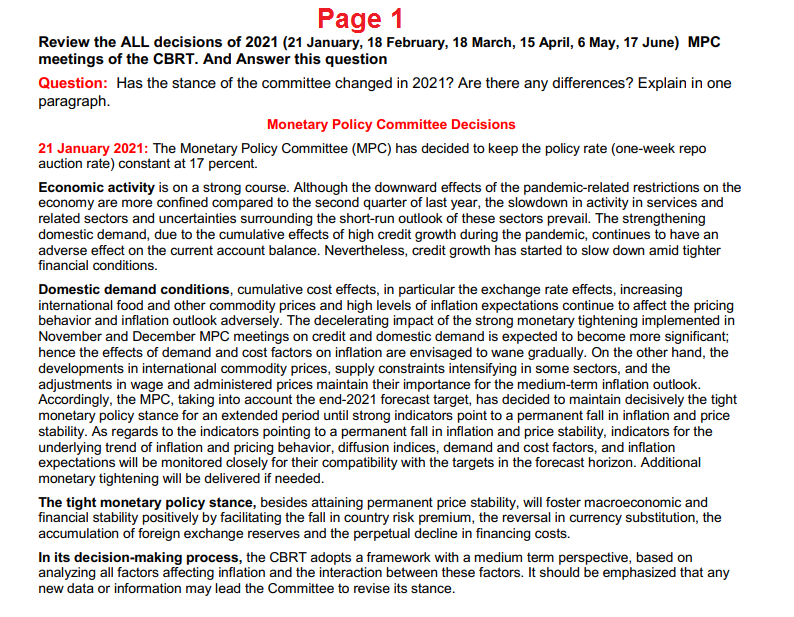
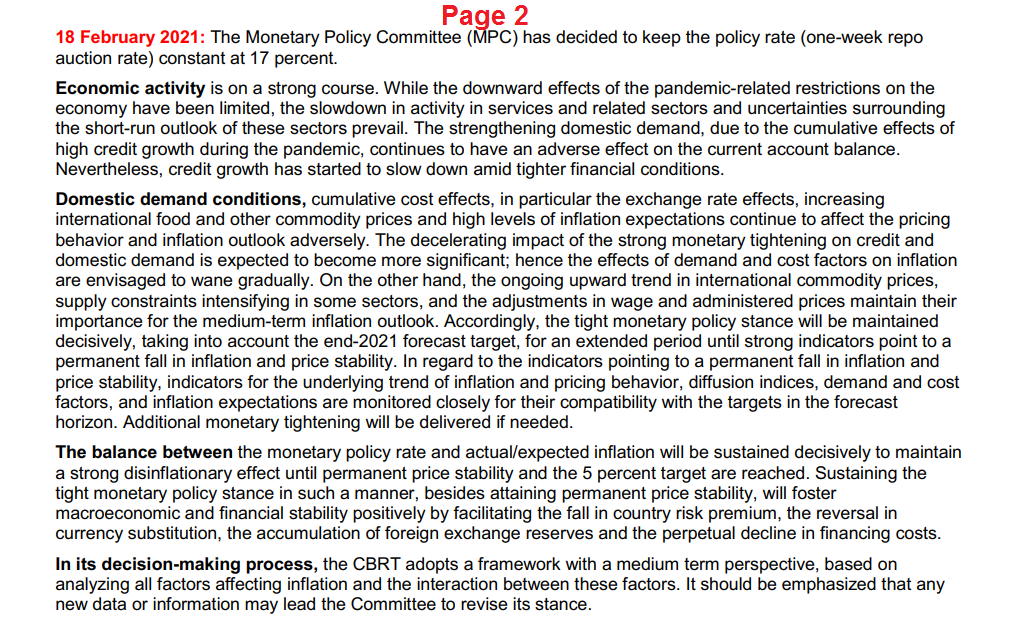
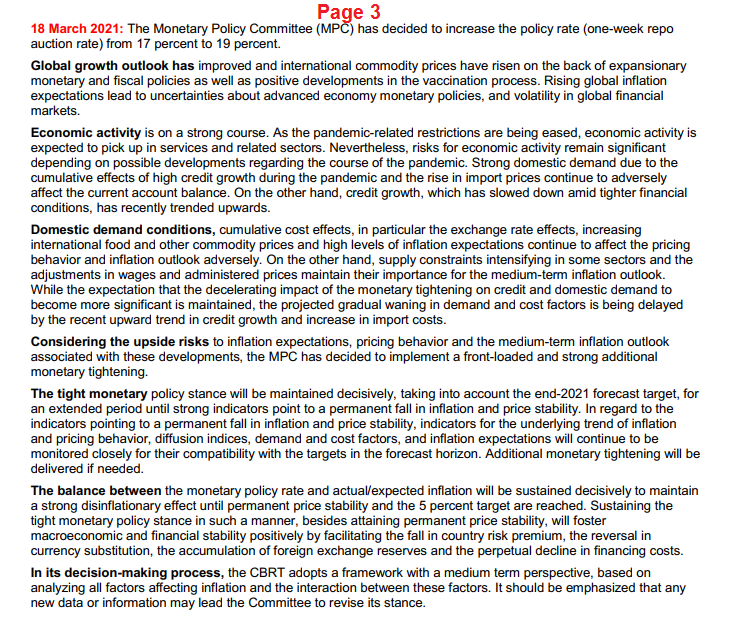
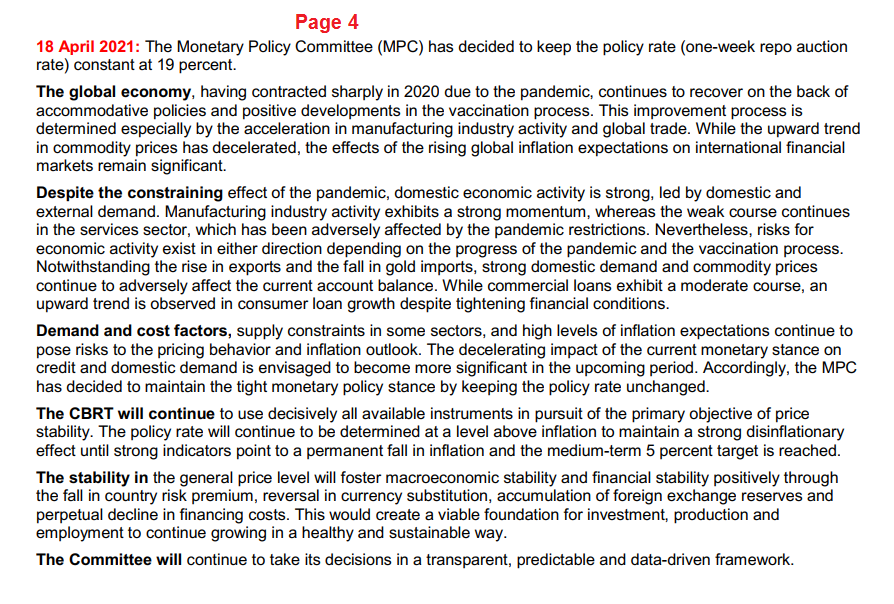
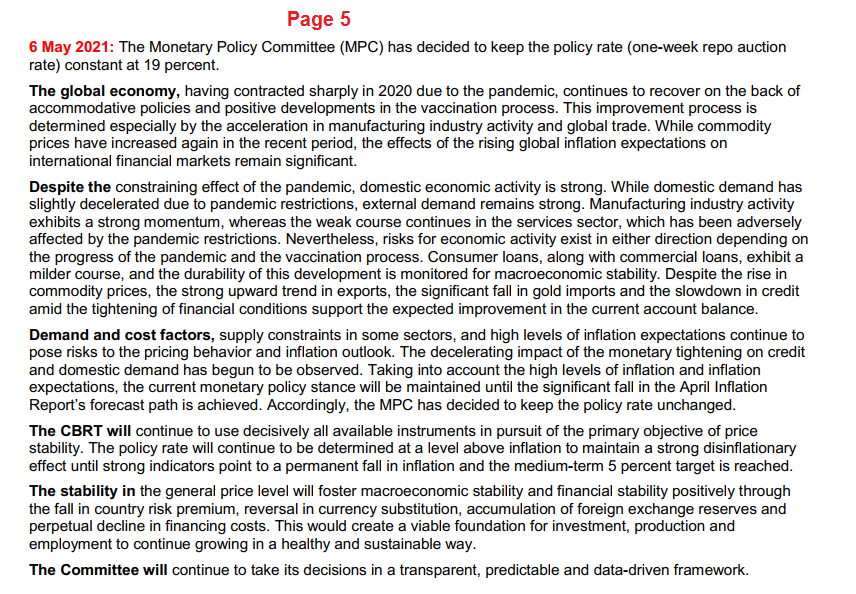

Page 1 Review the ALL decisions of 2021 (21 January, 18 February, 18 March, 15 April, 6 May, 17 June) MPC meetings of the CBRT. And Answer this question Question: Has the stance of the committee changed in 2021? Are there any differences? Explain in one paragraph. Monetary Policy Committee Decisions 21 January 2021: The Monetary Policy Committee (MPC) has decided to keep the policy rate (one-week repo auction rate) constant at 17 percent. Economic activity is on a strong course. Although the downward effects of the pandemic-related restrictions on the economy are more confined compared to the second quarter of last year, the slowdown in activity in services and related sectors and uncertainties surrounding the short-run outlook of these sectors prevail. The strengthening domestic demand, due to the cumulative effects of high credit growth during the pandemic, continues to have an adverse effect on the current account balance. Nevertheless, credit growth has started to slow down amid tighter financial conditions. Domestic demand conditions, cumulative cost effects, in particular the exchange rate effects, increasing international food and other commodity prices and high levels of inflation expectations continue to affect the pricing behavior and inflation outlook adversely. The decelerating impact of the strong monetary tightening implemented in November and December MPC meetings on credit and domestic demand is expected to become more significant; hence the effects of demand and cost factors on inflation are envisaged to wane gradually. On the other hand, the developments in international commodity prices, supply constraints intensifying in some sectors, and the adjustments in wage and administered prices maintain their importance for the medium-term inflation outlook. Accordingly, the MPC, taking into account the end-2021 forecast target, has decided to maintain decisively the tight monetary policy stance for an extended period until strong indicators point to a permanent fall in inflation and price stability. As regards to the indicators pointing to a permanent fall in inflation and price stability, indicators for the underlying trend of inflation and pricing behavior, diffusion indices, demand and cost factors, and inflation expectations will be monitored closely for their compatibility with the targets in the forecast horizon. Additional monetary tightening will be delivered if needed. The tight monetary policy stance, besides attaining permanent price stability, will foster macroeconomic and financial stability positively by facilitating the fall in country risk premium, the reversal in currency substitution, the accumulation of foreign exchange reserves and the perpetual decline in financing costs. In its decision-making process, the CBRT adopts a framework with a medium term perspective, based on analyzing all factors affecting inflation and the interaction between these factors. It should be emphasized that any new data or information may lead the Committee to revise its stance. Page 2 18 February 2021: The Monetary Policy Committee (MPC) has decided to keep the policy rate (one-week repo auction rate) constant at 17 percent. Economic activity is on a strong course. While the downward effects of the pandemic-related restrictions on the economy have been limited, the slowdown in activity in services and related sectors and uncertainties surrounding the short-run outlook of these sectors prevail. The strengthening domestic demand, due to the cumulative effects of high credit growth during the pandemic, continues to have an adverse effect on the current account balance. Nevertheless, credit growth has started to slow down amid tighter financial conditions. Domestic demand conditions, cumulative cost effects, in particular the exchange rate effects, increasing international food and other commodity prices and high levels of inflation expectations continue to affect the pricing behavior and inflation outlook adversely. The decelerating impact of the strong monetary tightening on credit and domestic demand is expected to become more significant; hence the effects of demand and cost factors on inflation are envisaged to wane gradually. On the other hand, the ongoing upward trend in international commodity prices, supply constraints intensifying in some sectors, and the adjustments in wage and administered prices maintain their importance for the medium-term inflation outlook. Accordingly, the tight monetary policy stance will be maintained decisively, taking into account the end-2021 forecast target, for an extended period until strong indicators point to a permanent fall in inflation and price stability. In regard to the indicators pointing to a permanent fall in inflation and price stability, indicators for the underlying trend of inflation and pricing behavior, diffusion indices, demand and cost factors, and inflation expectations are monitored closely for their compatibility with the targets in the forecast horizon. Additional monetary tightening will be delivered if needed. The balance between the monetary policy rate and actual/expected inflation will be sustained decisively to maintain a strong disinflationary effect until permanent price stability and the 5 percent target are reached. Sustaining the tight monetary policy stance in such a manner, besides attaining permanent price stability, will foster macroeconomic and financial stability positively by facilitating the fall in country risk premium, the reversal in currency substitution, the accumulation of foreign exchange reserves and the perpetual decline in financing costs. In its decision-making process, the CBRT adopts a framework with a medium term perspective, based on analyzing all factors affecting inflation and the interaction between these factors. It should be emphasized that any new data or information may lead the Committee to revise its stance. Page 3 18 March 2021: The Monetary Policy Committee (MPC) has decided to increase the policy rate (one-week repo auction rate) from 17 percent to 19 percent. Global growth outlook has improved and international commodity prices have risen on the back of expansionary monetary and fiscal policies as well as positive developments in the vaccination process. Rising global inflation expectations lead to uncertainties about advanced economy monetary policies, and volatility in global financial markets. Economic activity is on a strong course. As the pandemic-related restrictions are being eased, economic activity is expected to pick up in services and related sectors. Nevertheless, risks for economic activity remain significant depending on possible developments regarding the course of the pandemic. Strong domestic demand due to the cumulative effects of high credit growth during the pandemic and the rise in import prices continue to adversely affect the current account balance. On the other hand, credit growth, which has slowed down amid tighter financial conditions, has recently trended upwards. Domestic demand conditions, cumulative cost effects, in particular the exchange rate effects, increasing international food and other commodity prices and high levels of inflation expectations continue to affect the pricing behavior and inflation outlook adversely. On the other hand, supply constraints intensifying in some sectors and the adjustments in wages and administered prices maintain their importance for the medium-term inflation outlook. While the expectation that the decelerating impact of the monetary tightening on credit and domestic demand to become more significant is maintained, the projected gradual waning in demand and cost factors is being delayed by the recent upward trend in credit growth and increase in import costs. Considering the upside risks to inflation expectations, pricing behavior and the medium-term inflation outlook associated with these developments, the MPC has decided to implement a front-loaded and strong additional monetary tightening. The tight monetary policy stance will be maintained decisively, taking into account the end-2021 forecast target, for an extended period until strong indicators point to a permanent fall in inflation and price stability. In regard to the indicators pointing to a permanent fall in inflation and price stability, indicators for the underlying trend of inflation and pricing behavior, diffusion indices, demand and cost factors, and inflation expectations will continue to be monitored closely for their compatibility with the targets in the forecast horizon. Additional monetary tightening will be delivered if needed. The balance between the monetary policy rate and actual/expected inflation will be sustained decisively to maintain a strong disinflationary effect until permanent price stability and the 5 percent target are reached. Sustaining the tight monetary policy stance in such a manner, besides attaining permanent price stability, will foster macroeconomic and financial stability positively by facilitating the fall in country risk premium, the reversal in currency substitution, the accumulation of foreign exchange reserves and the perpetual decline in financing costs. In its decision-making process, the CBRT adopts a framework with a medium term perspective, based on analyzing all factors affecting inflation and the interaction between these factors. It should be emphasized that any new data or information may lead the Committee to revise its stance. Page 4 18 April 2021: The Monetary Policy Committee (MPC) has decided to keep the policy rate (one-week repo auction rate) constant at 19 percent. The global economy, having contracted sharply in 2020 due to the pandemic, continues to recover on the back of accommodative policies and positive developments in the vaccination process. This improvement process is determined especially by the acceleration in manufacturing industry activity and global trade. While the upward trend in commodity prices has decelerated, the effects of the rising global inflation expectations on international financial markets remain significant. Despite the constraining effect of the pandemic, domestic economic activity is strong, led by domestic and external demand. Manufacturing industry activity exhibits a strong momentum, whereas the weak course continues in the services sector, which has been adversely affected by the pandemic restrictions. Nevertheless, risks for economic activity exist in either direction depending on the progress of the pandemic and the vaccination process. Notwithstanding the rise in exports and the fall in gold imports, strong domestic demand and commodity prices continue to adversely affect the current account balance. While commercial loans exhibit a moderate course, an upward trend is observed in consumer loan growth despite tightening financial conditions. Demand and cost factors, supply constraints in some sectors, and high levels of inflation expectations continue to pose risks to the pricing behavior and inflation outlook. The decelerating impact of the current monetary stance on credit and domestic demand is envisaged to become more significant in the upcoming period. Accordingly, the MPC has decided to maintain the tight monetary policy stance by keeping the policy rate unchanged. The CBRT will continue to use decisively all available instruments in pursuit of the primary objective of price stability. The policy rate will continue to be determined at a level above inflation to maintain a strong disinflationary effect until strong indicators point to a permanent fall in inflation and the medium-term 5 percent target is reached. The stability in the general price level will foster macroeconomic stability and financial stability positively through the fall in country risk premium, reversal in currency substitution, accumulation of foreign exchange reserves and perpetual decline in financing costs. This would create a viable foundation for investment, production and employment to continue growing in a healthy and sustainable way. The Committee will continue to take its decisions in a transparent, predictable and data-driven framework. Page 5 6 May 2021: The Monetary Policy Committee (MPC) has decided to keep the policy rate (one-week repo auction rate) constant at 19 percent. The global economy, having contracted sharply in 2020 due to the pandemic, continues to recover on the back of accommodative policies and positive developments in the vaccination process. This improvement process is determined especially by the acceleration in manufacturing industry activity and global trade. While commodity prices have increased again in the recent period, the effects of the rising global inflation expectations on international financial markets remain significant. Despite the constraining effect of the pandemic, domestic economic activity is strong. While domestic demand has slightly decelerated due to pandemic restrictions, external demand remains strong. Manufacturing industry activity exhibits a strong momentum, whereas the weak course continues in the services sector, which has been adversely affected by the pandemic restrictions. Nevertheless, risks for economic activity exist in either direction depending on the progress of the pandemic and the vaccination process. Consumer loans, along with commercial loans, exhibit a milder course, and the durability of this development is monitored for macroeconomic stability. Despite the rise in commodity prices, the strong upward trend in exports, the significant fall in gold imports and the slowdown in credit amid the tightening of financial conditions support the expected improvement in the current account balance. Demand and cost factors, supply constraints in some sectors, and high levels of inflation expectations continue to pose risks to the pricing behavior and inflation outlook. The decelerating impact of the monetary tightening on credit and domestic demand has begun to be observed. Taking into account the high levels of inflation and inflation expectations, the current monetary policy stance will be maintained until the significant fall in the April Inflation Report's forecast path is achieved. Accordingly, the MPC has decided to keep the policy rate unchanged. The CBRT will continue to use decisively all available instruments in pursuit of the primary objective of price stability. The policy rate will continue to be determined at a level above inflation to maintain a strong disinflationary effect until strong indicators point to a permanent fall in inflation and the medium-term 5 percent target is reached. The stability in the general price level will foster macroeconomic stability and financial stability positively through the fall in country risk premium, reversal in currency substitution, accumulation of foreign exchange reserves and perpetual decline in financing costs. This would create a viable foundation for investment, production and employment to continue growing in a healthy and sustainable way. The Committee will continue to take its decisions in a transparent, predictable and data-driven framework. Page 6 17 June 2021: The Monetary Policy Committee (MPC) has decided to keep the policy rate (one-week repo auction rate) constant at 19 percent. The worldwide speeding up of vaccination rollout, especially in developed countries, supports the global economic recovery. Nonetheless, the increasing trend of commodity prices, supply constraints in some sectors and the rise in transportation costs have led to producer and consumer price increases internationally. The effects of the rising global inflation and inflation expectations on international financial markets remain significant. Domestic economic activity is strong. While domestic demand has slightly decelerated in the second quarter due to pandemic restrictions and the tightening in financial conditions, external demand remains strong. The acceleration of domestic vaccination rollout facilitates the recovery in services and tourism sectors, which have been adversely affected by the pandemic, and leads to a more balanced composition in economic activity. Loan growth exhibits a mild course owing to the implemented monetary tightening. The course and composition of loans are monitored for macroeconomic stability. Despite the rise in commodity prices, the strong upward trend in exports, the slowdown in credit growth, the significant fall in gold imports and the strong progress in the vaccination program stimulating tourism activities are expected to accelerate the ongoing improvement in the current account balance. In addition to the recent import-price-based cost factors, demand conditions, supply constraints in some sectors, and high levels of inflation expectations continue to pose risks to the pricing behavior and inflation outlook. On the other hand, the decelerating impact of the monetary tightening on credit and domestic demand has begun to be observed. Taking into account the high levels of inflation and inflation expectations, the current tight monetary policy stance will be maintained decisively until the significant fall in the April Inflation Report's forecast path is achieved. Accordingly, the MPC has decided to keep the policy rate unchanged. The CBRT will continue to use decisively all available instruments in pursuit of the primary objective of price stability. The policy rate will continue to be determined at a level above inflation to maintain a strong disinflationary effect until strong indicators point to a permanent fall in inflation and the medium-term 5 percent target is reached. The stability in the general price level will foster macroeconomic stability and financial stability positively through the fall in country risk premium, reversal in currency substitution, accumulation of foreign exchange reserves and perpetual decline in financing costs. This would create a viable foundation for investment, production and employment to continue growing in a healthy and sustainable way. The Committee will continue to take its decisions in a transparent, predictable and data-driven framework
Step by Step Solution
There are 3 Steps involved in it
Step: 1

Get Instant Access to Expert-Tailored Solutions
See step-by-step solutions with expert insights and AI powered tools for academic success
Step: 2

Step: 3

Ace Your Homework with AI
Get the answers you need in no time with our AI-driven, step-by-step assistance
Get Started


